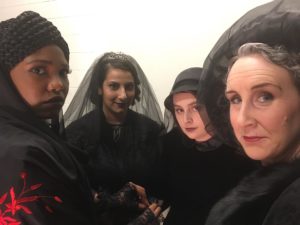Behind the Scenes at OSP’s Richard III
by Kae Koger*

L to R: Alexis Ward as Queen Margaret, Alyssa Fantel as Queen Elizabeth, Tyler Woods as King Richard III, Sarah Lomize as Duchess of York, Alexis Pudvan as Lady Anne. Photo Courtesy of OSP
The preparation for Oklahoma Shakespeare in the Park’s upcoming production of The Tragedy of King Richard III is largely invisible to the audience. Behind the scenes, members of the theatre’s staff and production team work to create a thrilling theatrical experience. Their work includes a myriad of details including measurements taken by the costume designer, the purchases made by the prop mistress, the plans drawn up and executed by the technical director and schedules created by the stage manager. Yet the patrons see the results of these labors when they enter the theatre. Unless an audience member is aware of it in advance, they will hardly ever notice the work of the dramaturg.
The dramaturg is historical, literary and cultural consultant to the production of a play and in that role I have been preparing for OSP’s production since last winter. Before the actors could be cast, the script had to be adapted to suit the needs of OSP. With the play’s original director, Judith Pender, I read and re-read Shakespeare’s text and made determinations about what scenes and characters might be cut. The original text contains over 29,000 words and has 53 speaking characters, much too long and over-populated for a contemporary production. Our goals were to keep the story clear, combine some characters and eliminate extraneous others, and to maintain Shakespeare’s rhythmic language while making sure each line was intelligible to our audience. The final version contains about 19,000 words and 25 characters, including Princess Elizabeth, whom Shakespeare did not include.
The decision to add a character (who does not speak) to Shakespeare’s play is also part of my work with the director. The primary goal of OSP’s production is to tell the story of Richard III’s rise to power and (spoiler alert!) ultimate demise. The Princess is Richard’s niece whose marriage at the end of the play indicates the establishment of a new dynasty and Richard’s complete defeat. Her presence on stage provides a concrete representation of the story’s progression.
Another aspect of my work is research into the historical facts and events surrounding the play’s narrative. Since Shakespeare based nearly all his characters on actual people, it is important for the actors to understand the relationships between them. My research focused on England’s Wars of the Roses and on Richard’s personal biography which led me to the important discovery that Shakespeare’s version of events is not strictly true. Not only does he compress events of 15 years into three, but he heightens Richard’s villainy for dramatic purposes. Scholars believe that Shakespeare promoted the Tudor view of Richard III, a murderous, “bunchbacked toad” to please Queen Elizabeth I, a descendent of Richard’s nemesis, Henry Tudor. History reveals that Richard was not visibly hunchbacked (although he did have scoliosis) and that he was, in fact, a brave warrior and a just ruler. There is, of course, still debate about whether Richard ordered the murder of his nephews (the rightful heirs to the throne), but Shakespeare was more interested in drama and political intrigue than historical accuracy and so is OSP.

L to R: Alexis Ward as Queen Margaret, Alyssa Fantel as Queen Elizabeth, Alexis Pudvan as Lady Anne and Sarah Lomize as Duchess of York. Photo courtesy of OSP
As dramaturg I shared my research with the director, actors and designers in order to give them a foundation for their creative work. I drew up a character biography for each character, based upon my research. I also led the cast through an overview of the historical events and political factions depicted in the play. During a week of table work (reading the play aloud without movement), I helped to answer actors’ questions about meaning and interpretation of their dialogue.
A dramaturg’s work on production changes as the rehearsal period progresses. While the actors are learning their lines, their blocking (movement on stage) and rehearsing fight choreography, I listen to the text and make sure that every line makes sense. I also begin thinking about the audience’s experience and how I might help to enhance their enjoyment. Writing program notes and leading pre-show discussions like OSP’s Shakespeare Book Club are a more visible part of my job. I also watch rehearsals as the production comes together and give notes to the current director, Kathryn McGill, about the actors’ audibility and visibility on stage.
When you come to see Richard III at the Myriad Gardens Water Stage, you won’t see me around. But when you read the program and see that title “Dramaturg,” you’ll know how I–along with the director, designers, actors and technicians–shaped your theatrical experience of one of Shakespeare’s most remarkable plays.
*****
The Tragedy of King Richard III tells the story of the notorious English king’s brutal rise to power amid political machinations and family squabbles. Oklahoma Shakespeare in the Park’s production runs at the Myriad Gardens Water Stage in Oklahoma City at 8 p.m. on Sept. 13, 14, 15, 20, 21, 22, 27 and 28. It runs approximately 2 hours and 40 minutes with one 10-minute intermission. Tickets are $20 for adults, $15 for seniors, students and members of the military. They may be reserved by calling 1-800-838-3006 or on the OSP website: https://www.oklahomashakespeare.com/tickets/. The production includes scenes staged of violence that may not be appropriate for children under the age of 13. Patrons are encouraged to arrive early and bring refreshments.
* Dr. Alicia Kae Koger, Dramaturg for “The Tragedy of Richard III” is well known on the OU campus as the Professor of Theatre History and Dramaturgy. Koger received her MA and her PhD at the University of Michigan.